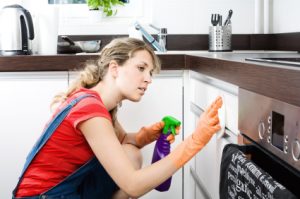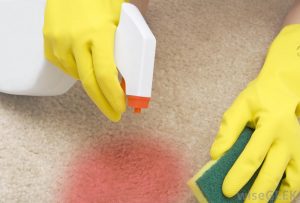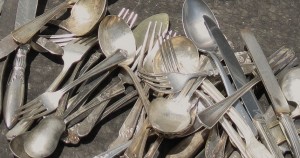Non-toxic Cleaning Tips with Common Ingredients
We love all the new non-toxic cleaning products on the market. But did you know that baking soda, vinegar, borax, salt, citrus and even ketchup can be effective, non-toxic cleaners? Your grandparents did. These cleaners are cheap, readily available, and you don’t have to worry about potentially harmful fumes. Check out these healthy cleaning tips, add these ingredients to your long-term storage, and read more at Eco-Coach.com.
Cleaning Tips for Spotless Kitchens
- Countertops and Sinks
Baking Soda and Water: Keep counters clean by sprinkling with baking soda, then scrubbing with a damp cloth or sponge. If you have stains, knead the baking soda and water into a paste and let set for a while before you remove. This method also works great for stainless steel sinks, cutting boards, containers, refrigerators, oven tops, and more.
Kosher Salt and Water: If you need a tougher abrasive on sinks and cast iron pans, sprinkle on kosher salt, and scrub with a wet cloth or sponge.
Natural Disinfectant: To knock out germs, mix 2 cups of water, 3 tablespoons of liquid soap, and 20 to 30 drops of tea tree oil. Spray or rub on countertops and other kitchen surfaces.
- Ovens
Baking Soda and Water: Coat the inside of your dirty appliance with a paste made from water and baking soda. Let stand overnight. Then don gloves and scour off that grime. Make spotless with a moist cloth.
- Fruits and Vegetables
Baking Soda: Worried about toxic pesticide residue, germs, and dirty fingerprints on your juicy peaches and crisp carrots? Just sprinkle a little baking soda on wet produce, then gently scrub and rinse.
Cleaning Tips for Beautiful Bathrooms
- Porcelain and Tile
Baking Soda and Water (with Kosher Salt): To keep bathroom surfaces clean and odor-free, dust with baking soda and scrub with a moist sponge or cloth. Kosher salt can be added to the mix to help with tougher grime.
Lemon Juice or Vinegar: Attack stains, mildew, and any grease streaks by spraying or dousing with lemon juice or vinegar. Let sit a few minutes, then scrub with a stiff brush.
Disinfectant: Instead of using bleach, make your own bathroom disinfectant by mixing 2 cups of water, 3 tablespoons of liquid soap, and 20 to 30 drops of tea tree oil. Even safer (tea tree oil is estrogenic), use hydrogen peroxide in the place of bleach. It disinfects and kills mold.
- Mirrors and Windows
White Vinegar, Water, and Newspaper: No, your mother-in-law isn’t a vampire; you just need to clean those mirrors. It’s simple: mix 2 tablespoons of white vinegar with a gallon of water, and dispense into a used spray bottle. Squirt on, then scrub with newspaper, not paper towels, which cause streaking.
If you can’t stand the smell of vinegar, you can substitute straight lemon juice or club soda (don’t dilute either in water).
- Clogged Drain
Baking Soda and Boiling Water (Vinegar If Needed): Feeling plugged up? Pour 1/2 cup of baking soda into the problem drain, followed by 2 cups of boiling water. If that isn’t doing it for you, chase the baking soda with a 1/2-cup of vinegar and cover tightly, allowing the vigorous fizzing of the chemical reaction to breakup the gunk. Then flush that with one gallon of boiling water.
Cleaning Tips for Flooring
- Wood Floors
Oil and White Vinegar: You’ve heard that wood floors are more hygienic than carpet, but you aren’t sure how to keep that gorgeous glow all year long. Just mix equal parts oil and white vinegar, and apply in a thin coat. Rub it in well to bring out the best in the grain.
- Carpet and Rugs
Club Soda: If you do have carpet, or even just some area rugs, it’s inevitable that someone will spill something colored. Your best defense is to clean it up immediately with club soda. Here’s how: first, carefully lift off any solids. Then liberally pour on club soda. Blot with an old rag until all the color from the spill is absorbed by your cloth. The soda’s carbonation should bring the spill to the surface, and the salts in the soda thwart staining.
Cornmeal: For big spills, dump cornmeal on the mess, wait 5 to 15 minutes, and vacuum up all the gunk.
Spot Cleaner: Make yourself a spot cleaner by mixing: 1/4 cup liquid soap or detergent in a blender, with 1/3 cup water. Mix until foamy. Spray on, then rinse with vinegar.
Just Beat It: For routine cleaning, take rugs outside and beat the dirt out of them the old-fashioned way.
To Deodorize: Sprinkle baking soda or cornstarch on the carpet or rug, using about 1 cup per medium-sized room. Vacuum after 30 minutes. Or mix two parts cornmeal with one part borax, sprinkle it around, and leave for an hour. Then vacuum.
The Fabrics of Our Lives
- Antique Linens
Sunlight: What could be easier than sanitizing and removing stains…with sunlight! (Just don’t do it too often with fragile pieces, because they can start to break down). Simply lay your old lace, curtains and other fine linens on the grass in the sun for a few hours. Dirtier pieces can be dampened first. This also works for mattresses. If a child pees on yours, get it out into the bright sun, which will deodorize and disinfect it. Sunlight will also disinfect water in re-used plastic soda bottles. Leave it out for as many hours as possible.
Boiling: If that doesn’t do the trick, fill a pot with water and bring to a boil on your stovetop. Drop in linens and let steep until stains lift.
Detergent and Borax: Mix dishwasher detergent and borax together until you get a thick rubbing paste. Rub into soiled linens, then rinse clean.
Peroxide: If you have stubborn stains, try spraying them with peroxide, then rinsing with water.
- Laundry
Baking Soda: To gently soften and deodorize a load of laundry, add in 1 cup of baking soda before you put in your regular soap and the clothes.
Borax: For heavily soiled items, add 1/2 cup borax to your regular detergent. As a bleach alternative, try 1/4 cup borax mixed with 2 cups of water.
Cleaning Tips for Spotless Metals
- Silver
Aluminum Foil, Boiling Water, Baking Soda, and Salt: Keep your sterling shined with this seemingly magic method. Line your sink or a bucket with aluminum foil, and drop in tarnished silver. Pour in boiling water, a cup of baking soda and a dash of salt. Let sit for a few minutes. The tarnish will transfer from the silver to the foil.
Toothpaste: If you can’t immerse your items or are otherwise inclined to polish by hand, rub tarnished silver with toothpaste and a soft cloth. Rinse with warm water and dry. Instead of toothpaste, you can substitute a concoction made of 3 parts baking soda to 1 part water.
- Copper
Ketchup: To keep your copper pots, pans, and accents looking bright and shiny, try rubbing with ketchup.
Resource: If you want to go deeper and find out how to solve other cleaning conundrums around the house, check out Clean, The Humble Art of Zen-Cleansing by Michael de Jong.





